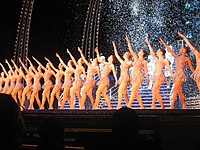
Photo from wikipedia
Coordinated and efficient operation in large, complex systems requires the synchronization of the rhythms of spatially distributed components. Such systems are the basis for critical infrastructure such as satellite navigation,… Click to show full abstract
Coordinated and efficient operation in large, complex systems requires the synchronization of the rhythms of spatially distributed components. Such systems are the basis for critical infrastructure such as satellite navigation, mobile communications, and services like the precision time protocol and Universal Coordinated Time. Different concepts for the synchronization of oscillator networks have been proposed, in particular mutual synchronization without and hierarchical synchronization from a reference clock. Established network synchronization models in electrical engineering address the role of inevitable cross-coupling time delays for network synchronization. Mutual synchronization has been studied using linear approximations of the coupling functions of these models. We review previous work and present a general model in which we study synchronization taking into account nonlinearities and finite time delays. As a result, dynamical phenomena in networks of coupled electronic oscillators induced by time delays, such as the multistability and stabilization of synchronized states can be predicted and observed. We study the linear stability of nonlinear states and predict for which system parameters synchronized states can be stable. We use these results to discuss the implementation of mutual synchronization for complex system architectures. A key finding is that mutual synchronization can result in stable in- and anti-phase synchronized states in the presence of large time delays. We provide the condition for which such synchronized states are guaranteed to be stable.
Journal Title: IEEE Access
Year Published: 2022
Link to full text (if available)
Share on Social Media: Sign Up to like & get
recommendations!